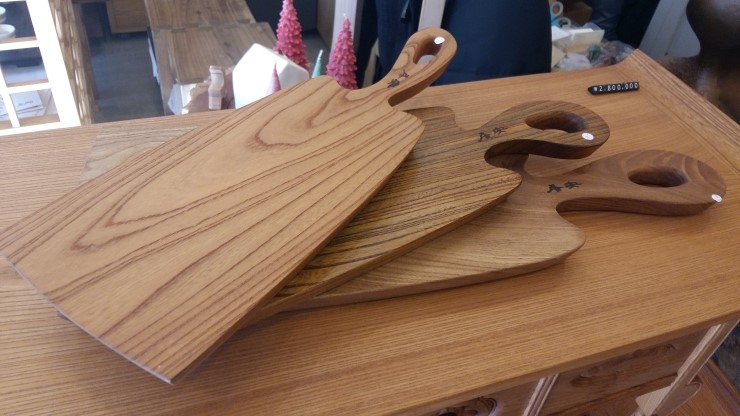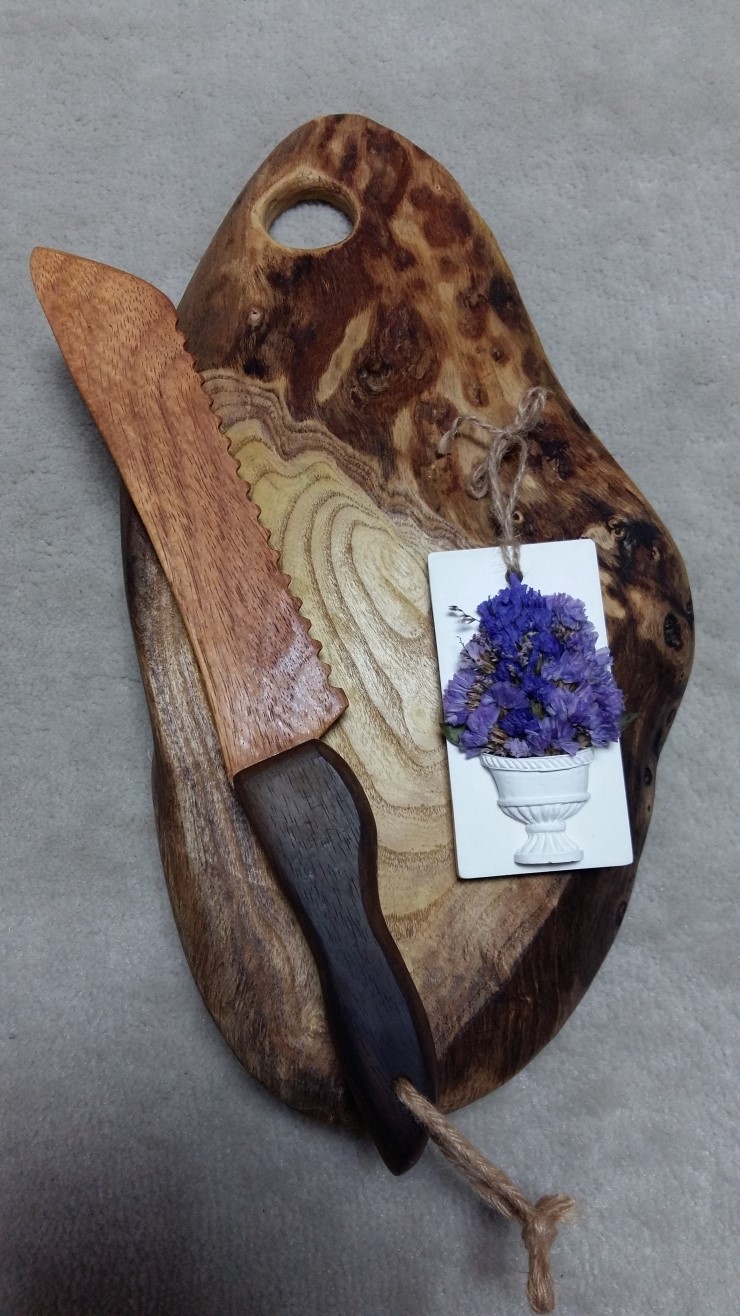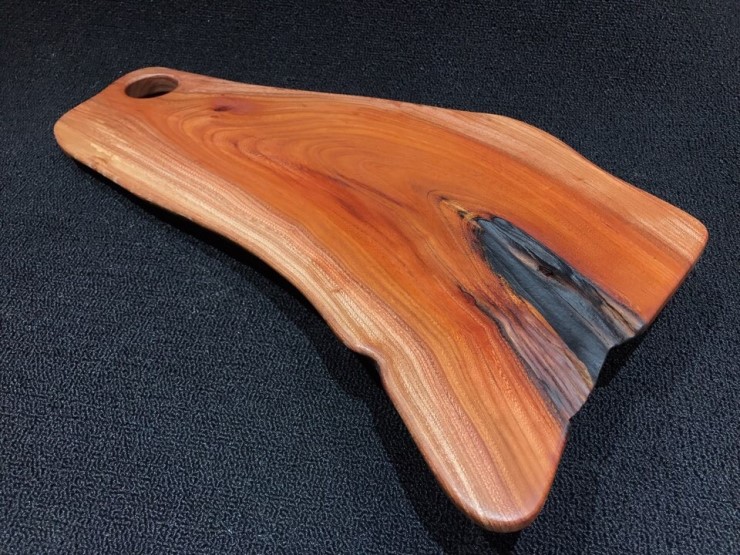아름답고 위생적인 원목 도마
Date2025-01-27
View 191
menu본문
요즘 원목 도마가 인기다.
하지만 일부 사용자는 목재의 특성상 혹시 위생에 문제가 되지 않을까 하여 빵도마와 같이 물기 없는 식품에만 한정되어 사용해야 하는 게 아닌가 하고 의문을 품는 경우가 많다. 마침 아래와 같은 좋은 자료가 있어 번역하여 첨부하니 참고하시길.



결론부터 말씀 드리자면 원목도마가 플라스틱 도마보다 훨씬 더 위생적이다. 물론 생재 도마가 아니라 잘 건조된(인공건조 된) 원목이 재료이어야 함은 기본 중에 기본이겠지만.
만약 플라스틱 도마를 사용하고 계신가? 그럼 위생에 주의하시고 잘 관리 하시라.
원목도마를 사용하고 계신가? 별로 신경 쓰지 마시고 사용후 필요하면 물로 휑구고 마른 행주로 물기만 제거 하시라. 위생은 걱정하지 마시고!
God’s Wood or Man’s Plastic?
신의 목재 아니면 인조 플라스틱?
Dave Miller, Ph.D.
Government agencies, like the USDA and the FDA, generally have advocated the use of plastic for cutting boards and other surfaces that sustain food contact, on the grounds that the micropores and knife cuts in wood provide hidden havens for deadly bacterial organisms. As one Extension Specialist from the Department of Human Nutrition stated: “for cleanability and control of microorganisms, plastic is the better choice.”
목재에 존재하는 미세한 구멍과 칼질에 의한 흠집이 치명적인 세균의 피난처가 될 수 있다는 이유를 근거로 들어 USDA 및 FDA와 같은 정부 기관이 도마나 음식물과 접촉이 계속 일어나게 되는 판의 용도로 플라스틱을 사용을 옹호해 왔다. Department of Human Nutrition의 영향력 있는 한 전문가는 세척 및 미생물 억제를 위해서는 플라스틱이 더 나은 선택이라고 이야기 한다.
However, the best research available on the subject suggests otherwise. Dr. Dean Cliver, a microbiologist with the Food Safety Laboratory and World Health Organization Collaborating Center for Food Virology at the University of California-Davis, disputes the oft’-repeated claim regarding the superiority of plastic over wood. His research findings, conducted over a period of several years, have consistently demonstrated the remarkable antibacterial properties of wood.
그러나 이 주제와 관련된 가장 우수한 연구는 다른 의견을 제시하고 있다. 미생물학자인 Cliver 박사(켈리포니아 대학교)는 목재보다 플라스틱이 더 좋다는 것에 대해 반박하고 있다. 수년간에 걸쳐 이루어져 온 그의 연구 결과는 목재의 뛰어난 항균성을 일관되게 증명하고 있다.
Dr. Cliver and his research associates have tested five life-threatening bacteria (Escherichia coli, Salmonella, Campylobacter jejuni, Listeria monocytogenes, and Staphylococcus aureus) on four plastic polymers and more than ten species of hardwood, including hard maple, birch, beech, black cherry, basswood, butternut, and American black walnut. Within 3 minutes of inoculating wooden boards with cultures of the food-poisoning agents, 99.9 percent of the bacteria were unrecoverable. On the other hand, none of the bacteria tested under similar conditions onplasticdied. In fact, leaving microbe populations on the two surfaces overnight resulted in microbial growth on the plastic boards, while no live bacteria were recovered from wood the next morning. Interestingly, bacteria are absorbed into the wood, but evidently do not multiply, and rarely if ever come back alive. In contrast, bacteria in knife scars in plastic boards remain viable (even after a hot-water-and-soap wash) and maintain their ability to surface later and contaminate foods. Treating wood cutting boards with oils and other finishes to make them more impermeable actually retards wood’s bactericidal activity. Microbiologists remain mystified by their inability to isolate a mechanism or agent responsible for wood’s antibacterial properties.
Cliver 박사와 그의 연구진들은 4종류의 플라스틱과 경단풍나무, 자작나무, 너도밤나무, 흑벚나무, 피나무, 버터호두나무 및 흑호두나무를 포함한 10종류 이상의 활엽수재를 대상으로 하여 5종류의 치명적인 박테리아(대장균、 살모넬라균, 캄필로박터 제주니、리스테리아균 및 황색 포도상 구균)로 시험을 실시하였다. 목재 도마에 식중독의 원인이 되는 균을 접종한 지 3분 이내에 박테리아의 99.9% 이상이 죽은 반면 비슷한 조건에서 시험했을 때 플라스틱에서 죽은 것은 아무것도 없었다.
사실, 두 표면에 박테리아 군집을 하룻밤 동안 방치해 두었을 때 다음날 아침 플라스틱 도마에서는 박테리아가 계속 생장을 계속하고 있는 반면 목재 도마에서는 어떤 살아 있는 박테리아도 찾아볼 수 없는 결과를 나타냈다. 흥미롭게도 박테리아가 목재 내부로 침투하였지만 전혀 증식하지 못했으며 살아 있는 것을 찾아보기란 힘이 들었다. 이와는 달리 플라스틱 도마의 칼자국에 존재하는 박테리아는 여전히 살아 있었으며(뜨거운 물과 세제로 세척한 다음조차도) 후에 표면에서 그 능력을 그대로 유지하여 음식물을 오염시켰다. 목재 도마를 기름을 먹이거나 도장 처리하게 되면 투과성이 봉쇄돼 실제로 박테리아 활동을 지연시키게 된다. 미생물학자들은 목재가 지니는 항균성에 대한 원인 물질이나 기작은 아직 완전히 알려 지지 않았고 이에 대한 궁금증은 여전히 미해결 상태로 남아 있다고 밝혔다.
Do these research findings bear any resemblance to Mosaic injunctions 3,500 years ago which required the destruction of pottery that had become contaminated—while wood was simply to be rinsed (Leviticus 6:28; 11:32-33; 15:12)? Dr. Cliver concluded: “I have no idea where the image of plastic’s superiority came from; but I have spent 40 years promoting food safety, and I would go with plastic if the science supported it. I don’t necessarily trust ‘nature,’ but I do trust laboratory research.” Kudos to Dr. Cliver’s honesty. What about trusting nature’s God?
이런 연구결과는 3,500년 전 목재는 단지 세척만 했던 반면 오염된 도자기를 파괴시키라고 했던 모세의 말과 어떤 닮은 점이 있는 것일까?(성서 레위기 6장 28절, 11장 32절-33절, 15장 12절) Cliver박사는 “플라스틱이 더 좋다는 발상이 어디서 유래했는지는 모르겠고; 나 또한 식품의 안전성을 제고하기 위해 40년을 바쳐 왔다. 만약 과학이 증명만 한다면 나도 플라스틱과 함께 하겠다. 나는 필연적으로 자연을 믿는 것은 아니지만 실험 결과는 전적으로 신뢰하고 있다”라고 결론지었다.
Cliver 박사의 솔직함에 대해 찬사를 보낸다.
자연의 신을 믿는 것이 어떻겠는가?
REFERENCES
참고문헌
Cliver, Dean O. (2002), “Plastic and Wooden Cutting Boards,” Unpublished manuscript.
Cliver, Dean O. (2002), personal letter.
Penner, Karen (1994), “Plastic vs. Wood Cutting Boards,” Timely Topics, Department of Human Nutrition, K-State Research and Extension.
Raloff, Janet (1993), “Wood Wins, Plastic Trashed for Cutting Meat,” Science News, 143[6]:84-85, February 6.
Raloff, Janet (1997), “Cutting Through the Cutting Board Brouhaha,” Science News Online, Food For Thought, July 11.
출처:

댓글목록
등록된 댓글이 없습니다.


